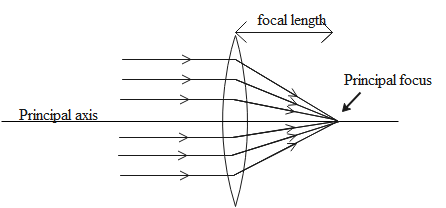
Define principal focus of the convex lens.
Answer
583.8k+ views
Hint: When the parallel light rays pass through a convex lens, they tend to converge and meet each other at a certain point. The principal axis is the axis passing through the centre of the lens.
Detailed step by step solution:
There are two main types of lens: concave lens and convex lens.
A concave lens diverges the light rays passing through it while a convex lens converges the light rays passing through it.
A line passing through the centre of the lens perpendicular to the axis of the lens is called the principal axis of that lens. A focus can be defined as the point where parallel light rays converge to meet after passing through the convex lens. In the case of a concave lens, the focus is a point where the parallel light rays passing through the lens appear to be originating from. A lens has two foci as it is made of two different curved surfaces, one on the left side of the lens and other on the right side of the lens.
When parallel light rays are incident on a convex lens, they converge and meet at a point called the principal focus after passing through the lens. These parallel light rays are also parallel to the principal axis.

Note: The difference between focus and principal focus that focus is the point where parallel rays meet each other. The rays may not always be parallel to the principal axis but in case of principal focus, the parallel rays also parallel to the principal axis. We can say that principal focus is a special type of focus.
Detailed step by step solution:
There are two main types of lens: concave lens and convex lens.
A concave lens diverges the light rays passing through it while a convex lens converges the light rays passing through it.
A line passing through the centre of the lens perpendicular to the axis of the lens is called the principal axis of that lens. A focus can be defined as the point where parallel light rays converge to meet after passing through the convex lens. In the case of a concave lens, the focus is a point where the parallel light rays passing through the lens appear to be originating from. A lens has two foci as it is made of two different curved surfaces, one on the left side of the lens and other on the right side of the lens.
When parallel light rays are incident on a convex lens, they converge and meet at a point called the principal focus after passing through the lens. These parallel light rays are also parallel to the principal axis.

Note: The difference between focus and principal focus that focus is the point where parallel rays meet each other. The rays may not always be parallel to the principal axis but in case of principal focus, the parallel rays also parallel to the principal axis. We can say that principal focus is a special type of focus.
Recently Updated Pages
Master Class 12 English: Engaging Questions & Answers for Success

Master Class 12 Business Studies: Engaging Questions & Answers for Success

Master Class 12 Economics: Engaging Questions & Answers for Success

Master Class 12 Social Science: Engaging Questions & Answers for Success

Master Class 12 Maths: Engaging Questions & Answers for Success

Master Class 12 Chemistry: Engaging Questions & Answers for Success

Trending doubts
What are the major means of transport Explain each class 12 social science CBSE

Which are the Top 10 Largest Countries of the World?

Draw a labelled sketch of the human eye class 12 physics CBSE

Explain sex determination in humans with line diag class 12 biology CBSE

The pH of the pancreatic juice is A 64 B 86 C 120 D class 12 biology CBSE

Explain sex determination in humans with the help of class 12 biology CBSE




